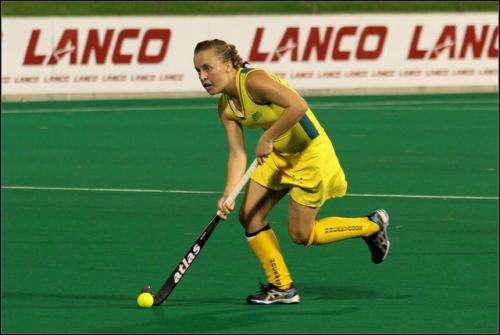The loads through hip, knee and ankle movements during unplanned sidestepping of 13 Hockeyroos were calculated before and after the training program. Credit: Chris Bartle
With the help of the Hockeyroos UWA researchers have developed a hip and trunk training program that could reduce the high rates of anterior cruciate ligament (ACL) injuries in all levels of sport.
Females are about five times more likely to suffer an ACL injury and more than half of these come from non-contact sidestepping movements.
The Hockeyroos had four non-contact ACL injuries in the year prior to the training program.
The nine week program developed by the School of Sport Science, Exercise and Health used combinations of plyometric, balance and strength body weight exercises to improve control of the trunk and hip during dynamic tasks.
Since the program the participants have not recorded a single non-contact ACL injury.
UWA Assistant Professor Cyril Donnelly says the program was designed using previous research, which shows there is a causal link between an individual's upper biomechanics, knee loading and injury risk.
"Rather than look at specific types of training we said 'why don't we refocus it and look at what we know mechanically reduces loads and therefore injury risk'," he says.
"So the focus of the training intervention was the hip and trunk musculature with an additional focus on the gastrocnemius muscle group."
The loads through hip, knee and ankle movements during unplanned sidestepping of 13 Hockeyroos were calculated before and after the training program.
Program leads to less muscle stress
After the program muscle activation in the gluteal medius and maximus (bottom muscles) during sidestepping increased by more than 20 per cent.
They also recorded a 30 per cent reduction in frontal plane knee loading among athletes at a high risk of injury.
A/Prof Donnelly says working with the Hockeyroos made sense because of the high rate of ACL injuries at the club.
"They approached us in 2012 because they had I think it was four non-contact ACL injuries in one year and if you look at the injury rates that's four time higher than a typical AFL club," he says.
"There was a big concern for them."
He says their team is testing the training paradigm among community level athletes so more sports teams from professional levels to amateur can use it.
"We want the whole design to be adaptable and malleable so it's moving the design of injury prevention training intervention from the type of exercises used [plyometric, resistance, balance] to the intended biomechanical focus of the exercises used within them," he says.
The program involves lunges, burpies and lateral bounds.
Provided by Science Network WA




















